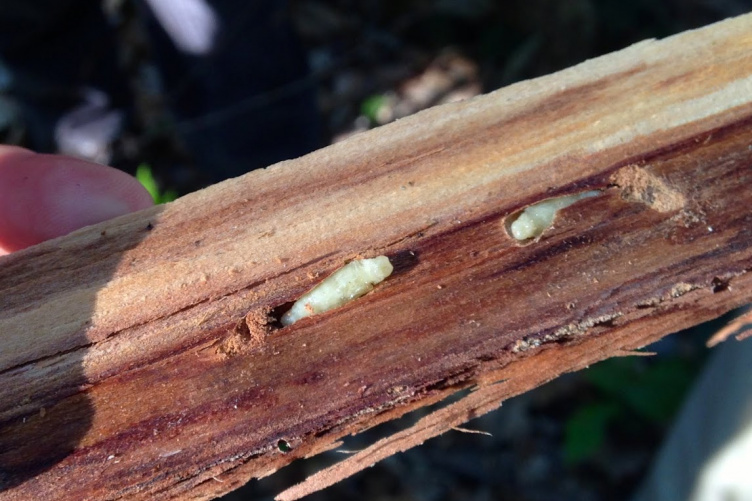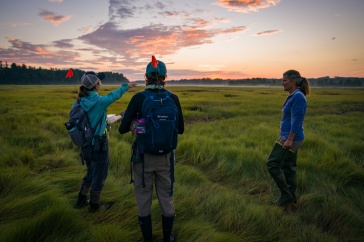
The shiny green, half-inch-long bugs on display one recent evening at Canterbury Shaker Village don’t sting or bite or carry a nasty disease, but their mere presence in some stately old ash trees near the village is raising the alarm for landowners, loggers and firewood dealers across the state.
The jewel-toned beetles are emerald ash borers, the latest invasive pest to arrive in the Granite State. Although they are harmless to people, they can kill ash trees in a matter of years and now pose a serious threat to the Granite State’s valuable stands of ash.
It’s been about a year since the emerald ash borer, which is native to Asia, was first discovered in New Hampshire, in a patch of trees near a Concord highway. Since then, UNH Cooperative Extension has worked with state agencies to stem its spread and to help residents identify, treat and replace affected trees. A big part of that effort is educational events like one that drew about 30 people to Shaker Village in late June.
New Hampshire’s ash crop represents 6 percent of the state’s northern hardwood forests. And left unchecked, the ash borer has the potential to kill these shade trees that are known for producing high-quality wood. The infestation is limited to Merrimack County, but it is expected to spread quickly, which is why educational events like the one at Shaker Village are so important.
“This is just the tip of the iceberg,” says Tim Fleury, a forestry resources educator with UNH Cooperative Extension. “Everybody is going to be wondering what to do.”
The nation’s first ash border infestation was identified in Detroit in 2002, although scientists believe it arrived in the early 1990s. As of this spring, infected trees had been identified in 23 states and two Canadian provinces. Federal restrictions on the shipment of firewood and other timber products have slowed the bugs’ spread, but it is not expected to completely stop anytime soon.
Ash borers live under a tree’s bark, laying eggs that produce tiny, cream-colored grubs with voracious appetites. Once hatched, the hungry larvae chew S-shaped tracks through the vital layers of wood that produce new growth in a tree. After about a year of feasting, the larvae morph into adult borers, which leave telltale D-shaped exit holes in a tree’s bark as they emerge to find a new host. Within 3 to 5 years, infected trees die.
Although it’s unlikely New Hampshire will ever completely rid itself of the bugs, Cooperative Extension is working to connect landowners with state experts who can help them minimize the damage.
One of those experts is Kyle Lombard, a forest entomologist with the state’s Division of Forests and Lands. Lombard, who graduated from the Thompson School of Applied Science in 1987 and UNH in 1990, spent about an hour at the Canterbury workshop demonstrating how trees can be treated with pesticides injected with large syringe-like tools. Such treatments can be effective, Lombard says, but they’re also expensive and may not work on heavily damaged trees.
“Once you decide the tree is valuable to you, you have to decide if it’s healthy enough to take pesticide,” he says.
Lombard and his colleagues hope to offer landowners a non-chemical alternative that involves fighting one species of invasive bug with another: a type of tiny, non-stinging wasp that curtails the ash borer in Asia. It’s a technique that’s being tested in a stand of ash trees next to Tim and Jill Meeh’s Canterbury hayfields.
The Meehs first spotted the suspiciously sick trees this spring near their tidy, lush farm. Although ash trees are a small part of their timber crop, the family would still like to stop the bugs from spreading.
“It’s not a huge economic impact,” says Tim Meeh. “It’s mostly an emotional thing that we’ll miss these trees. They’re beautiful shade trees. It’s just so sad to see them pretty much get a death sentence.”
In addition to educational events, the state is taking other measures to teach New Hampshire residents about the ash borers and the threat they pose. In May, Gov. Maggie Hassan declared Emerald Ash Borer Awareness Week, and Cooperative Extension is working with state agencies to provide information in person and online.
Cooperative Extension can help landowners confirm the existence of the ash borers as well as offer advice on treating or replacing infected trees.
“It’s early in the infestation,” Fleury says. “But when the trees start to die, they’ll be calling us.”
Emerald ash borer resources:
-
Written By:
Staff writer | Communications and Public Affairs


















































